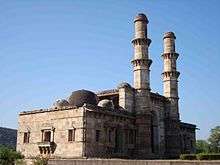Kevada Masjid, Champaner
| Kevada Masjid, Champaner | |
|---|---|
 Kevda Masjid, Champaner | |
 Shown within Gujarat  Shown within Gujarat | |
| Basic information | |
| Location |
|
| Geographic coordinates | 22°29′09″N 73°32′14″E / 22.4859°N 73.5371°ECoordinates: 22°29′09″N 73°32′14″E / 22.4859°N 73.5371°E |
| Affiliation | Islam |
| Municipality | Champaner |
| District | Panchmahal |
| State | Gujarat |
| Year consecrated | 15th century |
| Ecclesiastical or organizational status | Ruins |
| Status | Part of UNESCO Heritage Park |
| Heritage designation | Champaner-Pavagadh Archaeological Park |
| Leadership | Muhmad Begada |
| Architectural description | |
| Architectural type | Mosque |
| Architectural style | Blend of Hindu-Muslim Architecture |
| Completed | 15th century |
| Dome(s) | Five |
| Minaret(s) | Two |
| Materials | Rubble Masonry |
Kevada Masjid (also Kewda or Kevda) is a mosque in Champaner, Gujarat state, western India. It is part of the Champaner-Pavagadh Archaeological Park, a UNESCO World Heritage Site. The mosque has minarets, globe-like domes, and narrow stairs.[1] According to Ruggles (2008), nature was integrated into the Kevada mosque's architecture in a way that was unusual elsewhere in the Islamic world.[2]
This mosque was built in Champaner during the time of Mahmud Begada, as were several other masjids, such as the Bawaman, Ek Minar, Jama, Khajuri, Nagina, and Shahar Ki.[3] After James Burgess and Henry Cousens wrote descriptions of the Kevada, Jama, and Nagina Masjids, roads were built to reach them.[4] The Kevada is notable because of its mausoleum. Kathra Masjid is west of the Kevada.[5]
The masjid has many mehrabs, all intricately carved. There is a damaged brick tank for ablutions before prayers are offered at the mosque. The centotaph is square in shape with a fluted central dome and four corner domes; it is located next to the tank. The layout of the masjid is rectangularFloral and geometrical designs adorn the niches. The tribate inter-columns are considered attractive. The prayer hall, a double storied structure, had three domes but the central dome has since disappeared. The windows have balconies built over pillars with intricate carved decorations. There are two minarets, which are also decorated with intricate carvings.[6][7][8] Restoration works were carried out in the 1890s.[9]
Archaeological Survey of India (ASI) reports of 2006 indicate that extensive restoration works were carried out at the Kevada Masjid and also at many other monuments in Champaner-Pavagadh Archaeological Park, the Jami Masjid, fort walls, Bawana Mosque, Lila Gubaz, Sikandar Shah Tomb and Sikander tomb, which resulted in a slight increase in tourist traffic to the sites. ASI had already spent Rs 2.25 crores (about US $0.45 million) on conservation in a four-year period and a further Rs 1.15 crores (US $0.23 million) was allotted for more restoration work at the sites.[10]
See also
- List of Monuments of National Importance in Gujarat
- Monuments of Champaner-Pavagadh Archaeological Park
References
- ↑ Singh, Sarina (1 September 2009). India. LP. pp. 742–. ISBN 978-1-74179-151-8. Retrieved 29 September 2012.
- ↑ Ruggles, D. Fairchild; Silverman, Helaine (15 June 2009). Intangible Heritage Embodied. Springer. pp. 90–. ISBN 978-1-4419-0071-5. Retrieved 29 September 2012.
- ↑ Congress (2003). Proceedings of the Indian History Congress. Indian History Congress. p. 342. Retrieved 29 September 2012.
- ↑ Khanna, Amar Nath (1 February 1992). Archaeology of India: retrospect and prospect. Clarion Books. p. 223. ISBN 978-81-85120-17-1. Retrieved 29 September 2012.
- ↑ Gujarat (India) (1972). Gujarat State Gazetteers: Panchmahals. Directorate of Government Print., Stationery and Publications, Gujarat State. pp. 95, 762, 768. Retrieved 29 September 2012.
- ↑ "Mosques of Champaner". Official Web site of Government of Gujarat Tourism. Retrieved 29 September 2012.
- ↑ "World Heritage Sites - Champaner - Monuments at Champaner". Archaeological Survey of India. Retrieved 28 September 2012.
- ↑ B. Busa Goud. "Scientific Conservation of World Heritage Monuments of Champaner-Pavgadh" (pdf). UNESCO. Org. Retrieved 29 September 2012.
- ↑ Bombay (India : State). General Dept (1897). Archaeology, Progress Report. Bombay: Archaeological Survey of India. Western Circle. p. 8. Retrieved 1 October 2012. Missing
|last1=in Authors list (help) - ↑ "World heritage site Champaner-Pavagadh neglected". News Online. 11 November 2006. Retrieved 7 October 2012.
| Wikimedia Commons has media related to Kevada Masjid, Champaner. |